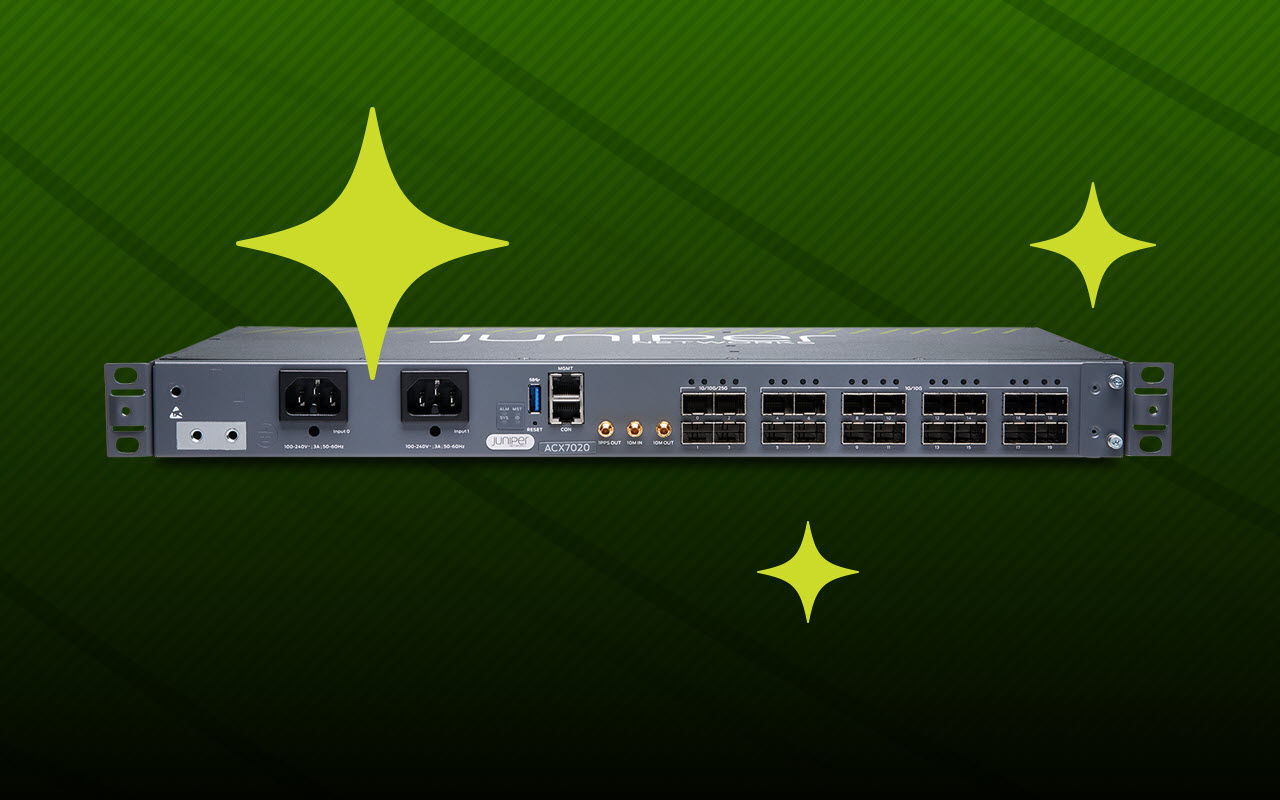This is the first in a series of blogs about the EANTC 2021 network interoperability testing event.
Once again, Juniper Networks demonstrated its leadership in routing innovation at the virtual MPLS SD & AI Net World Congress 2021 event last month. In July 2021, Juniper also participated in several multi-vendor interoperability tests organized by the European Advanced Networking Test Center (EANTC) in Berlin, Germany. The EANTC report is publicly available and can be found here.
Importance of Interoperability Testing
Previously, separate networks were often established to serve different functions. For example, one transport network was designed for mobile traffic and another transport network was designed for residential traffic. Recently, these networks have evolved into true multipurpose, multiservice networks. Furthermore, with the advent of 5G and network functions virtualization, the industry is experiencing greater integration between cloud and transport networks.
These heterogeneous networks are deployed with equipment from multiple vendors. Therefore, it’s increasingly important to ensure the various network elements can work together, enabling seamless network operations. Consequently, cloud providers and service providers drive open standards development to ensure smooth interoperability between network elements. However, sometimes these standards, emerging drafts and requests for comment (RFCs) leave room for interpretation. Thus, interoperability testing activities like those hosted by the EANTC drive the industry forward, enabling vendors to proactively identify potential discrepancies, collaborate, discuss outcomes and ultimately set the standard for the industry.
Customers generally try to avoid vendor-proprietary implementations to prevent vendor lock-in. That’s why industry interoperability events are the best tool to validate interoperability with other vendors, easing customer concerns about proprietary technology creep.
Juniper Networks’ Interoperability Leadership
Juniper has taken a leadership position with its industry interoperability testing since 2015 and this year was no different. In this year’s EANTC Interop testing, Juniper participated in end-to-end solution testing with industry vendors, including Cisco, Nokia, Arista and Huawei, among others, in the following categories:
- Transport Plane: SR-MPLS, SRv6
- Service Plane: EVPN-VXLAN, EVPN-MPLS
- Controller Plane: Paragon™ Pathfinder, Paragon Insights
- Timing and Synchronization: Class C & Class D T-BC
In addition to its extensive product portfolio, Juniper also brought some new contenders to the EANTC stage for interoperability testing, including the:
- Juniper Networks® ACX Series Universal Metro Routers (ACX710, ACX5448, ACX7100-48L)
- Juniper Networks® MX Series 5G Universal Routing Platforms (MX204, MX480, MX10008)
- Juniper Networks® PTX Series Packet Transport Routers (PTX10001-36MR, PTX100080)
- Juniper Networks® QFX Series Switches (QFX5110-48S, QFX5120-32C, QFX5120-48Y, QFX5120-48YM, QFX5210-64C, QFX10002-72Q)
Figure 1 below outlines these technology areas in a deployment scenario. Paragon Pathfinder and Paragon Insights optimize and automate the operation of the network. Synchronization is distributed from the Telecom Grand Master (T-GM) across the network with Telecom Boundary Clock (T-BC), enabled on the transit routers and up to the access routers, where mobile elements (eNB/gNB), enterprise routers or residential subscribers can be universally connected. These service flows are then transported across the network using a flexible Segment Routing (SR) transport option, whether that be SR-MPLS-based or SRv6-based.

Juniper Networks showed leadership in this area by demonstrating interoperability with other vendors across all domains of an end-to-end solution, supporting various layers of the protocol stack and implementing full closed-loop automation.
Interoperability Testing in the Transport Layer (Underlay)
Segment Routing (SR) simplifies the transport layer by eliminating the need to run separate MPLS protocols. Labels are exchanged via IGP or BGP extensions. Moreover, SR makes it possible to implement traffic engineering without keeping states on the transit routers. Instead, an appropriate label stack (determined by an external controller or by an on-box path computation component, per SLA requirements) is pushed at the headend router.
At EANTC 2021, Juniper tested several new SR features, including Flex-Algo Prefix Metrics (FAPM), Topology-Independent Loop-Free Alternate (TI-LFA) with remote SRLG, Flex-Algo with dynamically measured link delay metrics and more.
SRv6 is another important aspect of SR. Juniper performed basic SRv6 tests at EANTC 2020. This year, Juniper participated in multiple SRv6 tests, including VPNv4/VPNv6 over SRv6, global IPv4/IPv6 over SRv6, TI-LFA with SRv6 and SRv6 Flex-Algo with dynamic link delay measurements with TWAMP-Light for IPv6, showing readiness for potential SRv6 deployments.
A future blog will outline Juniper’s leadership in SR testing at the EANTC 2021 event.
Interoperability Testing in the EVPN Application (Service) Layer
EVPN continues to gain traction, whether in the data center environment with EVPN-VXLAN, or in the service provider environment with EVPN-MPLS. After many years of L2 services solutions based on bridging with data plane MAC learning, EVPN introduced control plane MAC learning, which opened a full spectrum of new possibilities for L2 services. This includes the integration between L2 and L3 (routing and bridging), highly optimized multicast distribution, efficient flood suppression (ARP, IGMP), all-active multi-homing capabilities and more.
Since its inception, Juniper has led the industry in standardization and implementation and since 2014, Juniper has led the industry in EVPN interoperability testing. This year, for the first time, Juniper tested optimized inter-subnet multicast (OISM), IPVPN Type-5 interworking with both EVPN-MPLS and EVPN-VXLAN and symmetric IRB routing with Type 2, a new MAC-VRF Junos construct. A future blog will include more details on Juniper’s EVPN testing at EANTC 2021.
Interoperability Testing in the Controller Layer
Paragon Pathfinder is a cloud-native controller that simplifies traffic engineering, making it easier to leverage benefits provided by transport service paths, such as MPLS/RSVP, segment routing and network slicing. It allows for more efficient management of strict transport service SLAs through automated planning, provisioning, proactive monitoring and optimization of large traffic loads dynamically, based on user-defined constraints. Paragon Pathfinder enables granular visibility into network traffic flows and optimizes network capacity through closed-loop automation. It monitors the network in real-time, gathering streaming telemetry, topology data from Netflow, IGP and BGP-LS from the network and analyzes the data to provision new service paths based on user-defined SLA constraints.
Additionally, for the first time, Juniper Networks participated in interoperability testing with Paragon Pathfinder at EANTC 2021 and the solution passed the challenges with excellent results. In previous EANTC tests, Paragon Pathfinder’s predecessor, NorthStar Controller, was extensively tested at EANTC interoperability testing events.
Paragon Insights is a cloud-native network health and diagnostic solution that provides operational intelligence across all service provider, cloud and enterprise network domains, from network access to servers in the data center. Its advanced algorithms and machine learning (ML) technology correlate collected data, establish operational benchmarks, determine anomalies and perform proactive corrective actions—all of which are critical to intent-based networking. Paragon Insights testing at EANTC 2021 demonstrated Juniper’s multi-vendor, multi-layer network automation solution with deep telemetry, analytics and remediation across the whole stack.
Timing and Synchronization Interoperability Testing
Timing and synchronization are important aspects of 5G transport network design. At EANTC 2021, Juniper proved its excellent support for both Precision Timing Protocol (PTP) and Synchronous Ethernet (SyncE) on a variety of different platforms.
Additionally, for the first time in the industry, EANTC officially verified Class D clocking support with Juniper Networks routers, using the ACX710 and ACX7100 routers. Class-D is currently the highest accuracy clock, still being defined by ITU-T, with the accuracy required for the new 5G fronthaul applications.
Conclusion
Once again, Juniper demonstrated its richest set of routing protocol features that customers can deploy in their networks, its significant leadership position in both service provider routing and data center switching and its role in transforming networking for the cloud era at EANTC 2021.
These multi-vendor interoperability tests provide the foundation to build interoperable networks incorporating equipment from industry vendors and help dispel others’ fears about proprietary implementations and vendor lock-in.
A series of follow-up blogs will outline Juniper’s participation in each of the technology areas. Learn more about previous EANTC interoperability testing here.

























